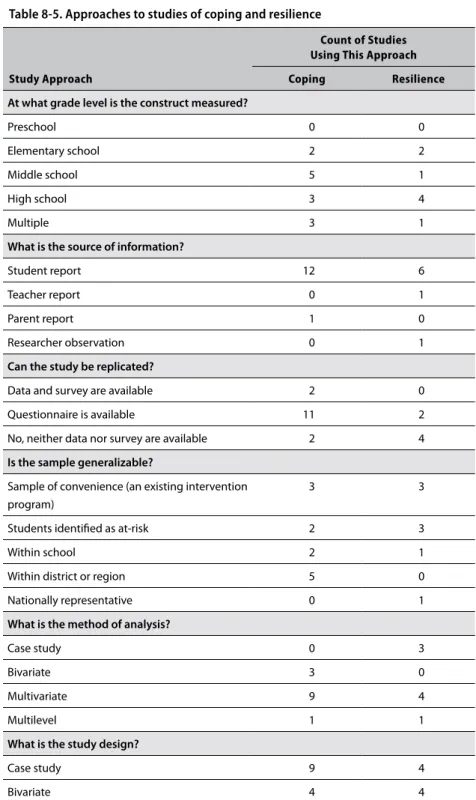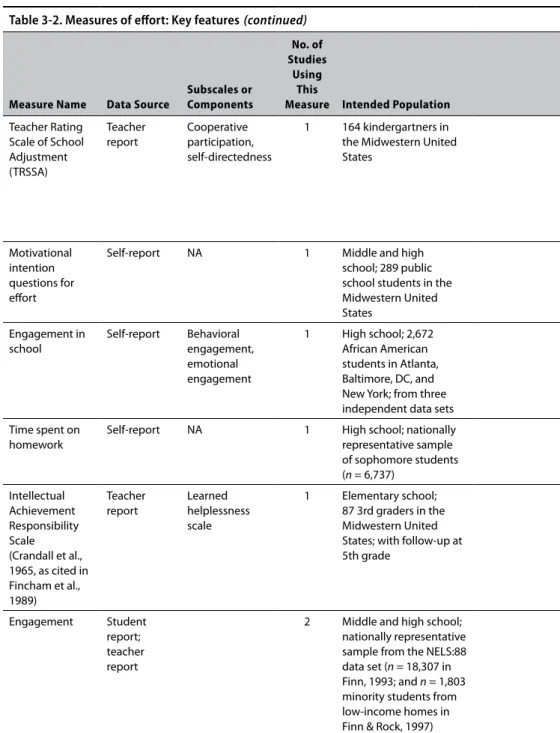Research on noncognitive skills is a relative newcomer to the study of factors that influence student performance and achievement. In addition, some researchers question the explanatory power of noncognitive skills and traits for educational performance or attainment.
In 2008, the authors of this manuscript received a grant from the Spencer Foundation to conduct a research synthesis on the effect of noncognitive skills and attributes on educational achievement in kindergarten through grade 12. Identifying articles on these noncognitive skills involved conducting a series of searches in the Education Resources Information Center and EBSCOhost databases.
Overview of the Chapters Motivation
We developed a process to gather information about these articles, including the definition of the skill, its relationship to other skills, the sample, the research method, and the relationship between the noncognitive skill and academic outcomes. These differences may arise from the differences in the measurement of skills, the definitions of risks and the specification of the models.
In the chapters that follow, readers will find definitions of each trait, critical assessments of commonly used standard measurement items, syntheses of some of the most recent research on these important traits, and how these traits may relate to key academic outcomes today. We hope that students and advanced researchers will find the information contained in the following chapters useful as they begin studies of the noncognitive.
Introduction
A second screening eliminated additional articles where (1) motivation, although used as a descriptor, was typically defined and used as another concept or idea (such as effort or homework behavior); (2) motivation was not a key predictor, outcome, or mediator (i.e., it was one predictor among many); and (3) a scientific study approach was not used (eg, reports of personal discussions with a handful of students).
Conceptual Definition
Both expectancy theory and achievement goal theory, described below, include a definition of intrinsic motivation that equates it with interest (e.g., see Eccles & Wigfield, 2002, p. 120; and measures used by Gehlbach, 2006 and Pintrich, 2000). . More formally, intrinsic motivation is a largely autonomous type of motivation, while extrinsic motivation is a controlled form of motivation that varies between low control and high control (Ryan & Deci, 2000; Vansteenkiste et al., 2006).
Other aspects of Motivation
According to this theory, students with mastery goals experience more engagement and greater learning than students with achievement goals. Students with mastery and approach goals are predicted to perform better than students with performance or avoidance goals.
Studies of achievement Motivation and School performance, 1997–2008
Here, students rated classmates or schoolmates for their level of interest or effort (e.g., Graham et al., 1998). These seven studies all found that positive aspects of motivation (i.e., intrinsic motivation, mastery orientations, or high task value) were positively associated with academic behaviors such as help-seeking (Marchand & Skinner, 2007) or planning (Lau & Lee, 2008) ) and negatively related to problem behavior (McDermott et al., 2001).
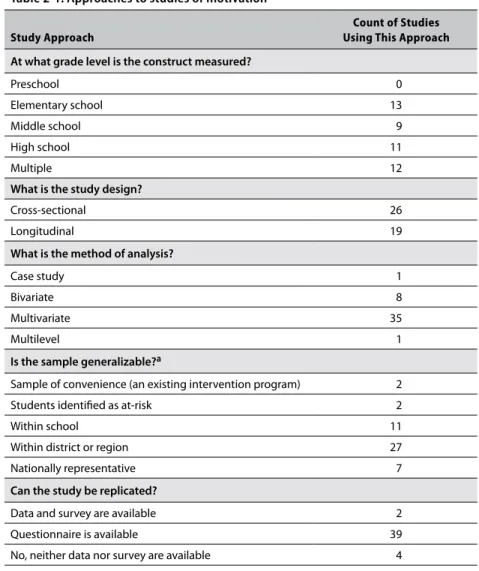
Discussion
This creates a multiplicative set of overlapping study-specific scales that measure different aspects of the same motivational constructs, have different levels of reliability (although usually high), and may exhibit other differences in statistical properties. In general, therefore, conclusions about the strength of the relationship between motivation and achievement depend on methodological design, conceptual definition, and operational measurement.
Conclusion
Assessing secondary students' disposition toward critical thinking: Development of the California Measure of Mental Motivation. Examining Hong Kong students' achievement goals and their relationship to students' perceived classroom environment and strategy use.
Conceptual Definitions
In general, procedural effort focuses on the completion of a task, while substantive effort focuses on active involvement in the task. The second conceptual dimension of effort identified in the literature is the degree of task specificity.
Measurement approaches
All but three studies used questions that attempted to quantify how hard the student worked. Two of the nine studies used performance-based indicators of effort rather than subjective self-assessments.
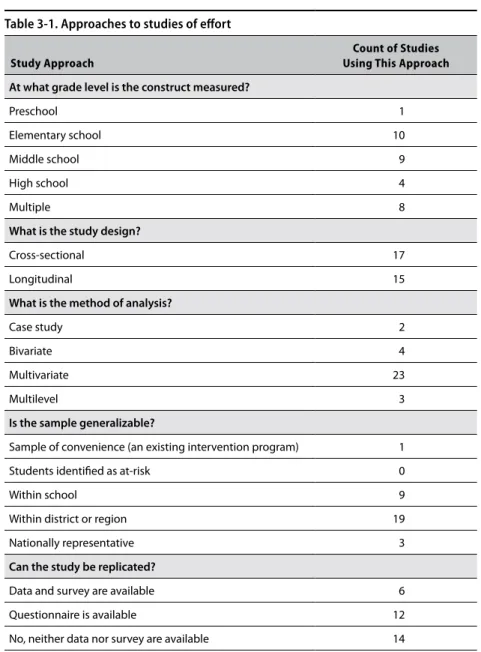
Measures of Self-regulation
Reliance on self-report also limits what can be learned about self-regulation in younger children, who are less able to articulate their mental processes. In this review of the literature, no single self-report questionnaire was found to be used with significantly greater frequency than any other (see Table 4-1). Eleven self-report measures were identified, and only one of these was used in more than one study.
Self-report Self-regulated learning (subscales of self-regulation and cognitive strategies), motivation (subscales of intrinsic motivation and self-efficacy).
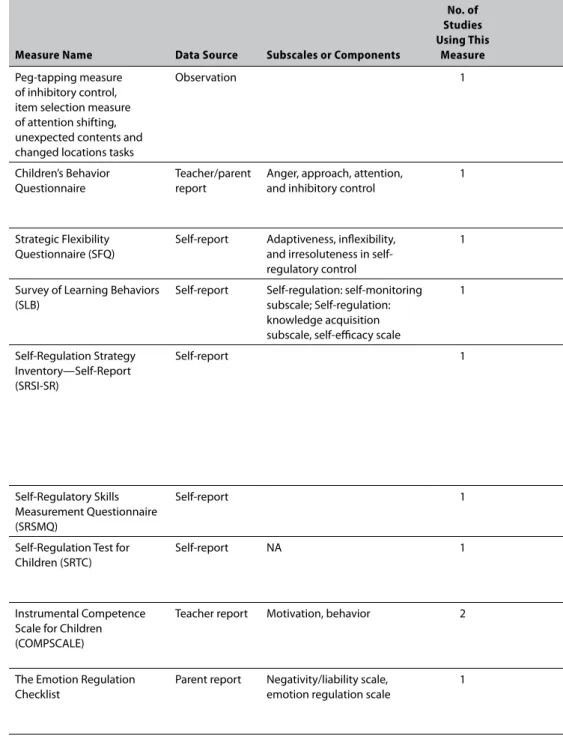
Studies of Self-regulation and School performance, 1997–2008
At kindergarten, children's IQ was measured early in the year, and academic skills were assessed at the end of the year. Paper presented at the annual meeting of the American Educational Research Association, New Orleans, LA. Preliminary construct and concurrent validity of the Preschool Self-Regulation Assessment (PSRA) for field-based research.
Although postsecondary attendance and achievement may be outcomes of the study, the initial measurement of self-efficacy should have occurred earlier.
Studies of Self-efficacy and School performance, 1997–2008 Measures Used
This section provides an overview of the number and types of measures currently used in self-efficacy research. In addition, several types of self-efficacy were measured, including academic self-efficacy, self-efficacy for self-regulated learning, and social self-efficacy. However, the relationship between academic self-efficacy and other types of self-efficacy (eg, self-regulatory and social self-efficacy) is debated.
Most studies examined self-efficacy in relation to grades (five in mathematics, five in general grades).
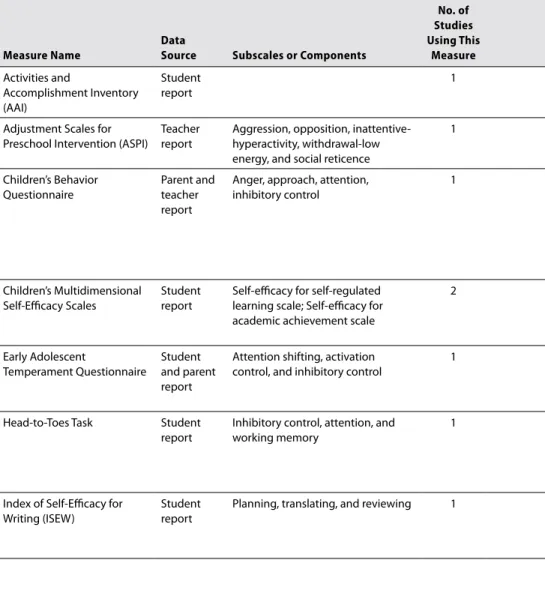
Behaviors
Meta-analysis of research from 1977 to 1988
These studies serve to illustrate the types of mediating questions addressed by academic self-efficacy research. Overall, they highlight the importance of self-efficacy in understanding variations in children's academic outcomes. Adaptive and effortful control and academic self-efficacy beliefs on achievement: A longitudinal study of first through third grade.
Self-motivation for academic achievement: The role of self-efficacy beliefs and personal goal setting.
Conceptual Definition in the educational Context
The issue of causality between academic self-concept and achievement outcomes has been prominent in the academic self-concept literature. The reciprocal effects model posits that prior self-concept predicts subsequent self-concept and subsequent academic achievement (Marsh & Craven, 2006). In this section, we discuss the specific approaches researchers have used to measure academic self-concept.
The ASDQ is a multidimensional (ie, more than one academic domain) self-concept instrument based on previous SDQ research.
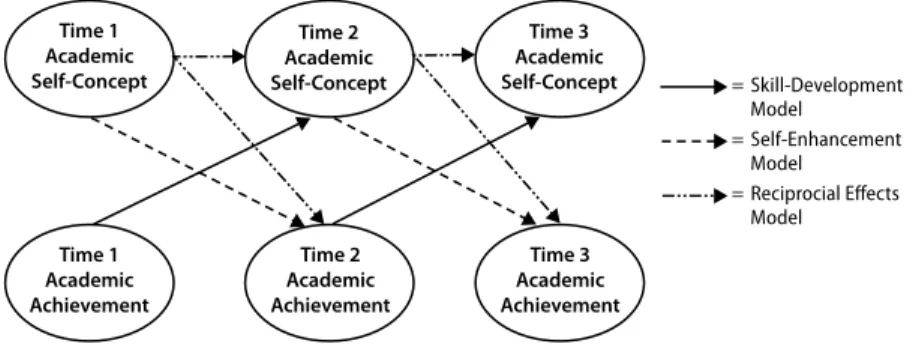
Studies of academic Self-Concept and School performance, 1997–2008
Higher levels of exclusion significantly predicted lower academic self-esteem and lower classroom engagement scores. But Buhs found a much weaker direct relationship between academic self-esteem and changes in academic performance. Causal effects of academic self-concept on academic performance: structural equation models of longitudinal data.
Longitudinal structural equation models of self-concept and academic achievement: Gender differences in the development of math and English constructs.
Studies of antisocial and prosocial Behavior and School performance, 1997–2008
Aggressive acts often occur away from parents, teachers, and other authorities (Hyman et al., 2006). This coverage of interrelated issues illustrates the recognition that the study of antisocial and prosocial behaviors involves two-way relationships with academic and social experiences. Further research could profitably explore how specific antisocial and prosocial behaviors relate to academic outcomes through measures of student relationships and social integration.
Therefore, common antisocial and prosocial behaviors have a greater significance than might otherwise be acknowledged.
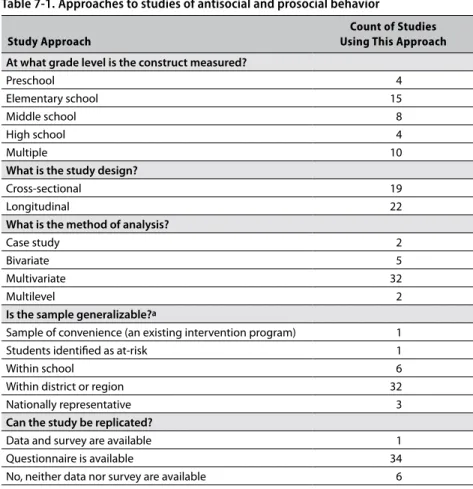
Coping and resilience
Resilience can be defined as “a dynamic process involving positive adaptation within the context of serious adversity” (Luthar et al., 2000, p. 543). Because resilience requires adaptation to serious disasters, only people who have experienced such threats can be considered resilient. Similarly, successful outcomes have been defined in a variety of ways from maintaining psychological well-being, to avoiding delinquency, to achieving social or academic success (Masten, 2001; Masten & Coatsworth, 1998).
Originally, scientists presented resilience as a personality trait, but more recent work describes it as a developmental process that is not static (Luthar et al., 2000).
Measurements of Coping
In another study, the authors created a scale they called a resilience scale (Jew et al., 1999) that included items such as "No matter what happens in life, I know we'll make it." Here, the authors selected their articles based on input from an expert panel that included psychiatrists, psychologists and a social worker. The Adolescent Coping Orientation Scale for Problem Experiences (Hawley et al., 2007) includes items for "seeking professional help" and "seeking spiritual support." Marchand and Skinner (2007) used a 5-item help-seeking scale, which included statements such as "When I have trouble with a subject at school, I ask the teacher to explain what I did not understand." Crean (2004) used a subscale, takes action to solve problems, from the Inventory of Coping Responses. Most of these studies (Crean, 2004; de Anda et al., 2000; Garber & Little, 1999) used Likert-type scales where students could state how often they act in various ways, such as "I make sure no one find out " or "I plan ways to get back at them." Swanson and colleagues (2003) found that African American males with exaggerated stereotypical ideas about men and race developed reactive coping attitudes and had poorer school performance.
Newman and colleagues (2000) asked open-ended questions about the strategies students used to respond to stress and categorized responses as individual (working hard), academic (students), and social (hanging out with the right crowd).
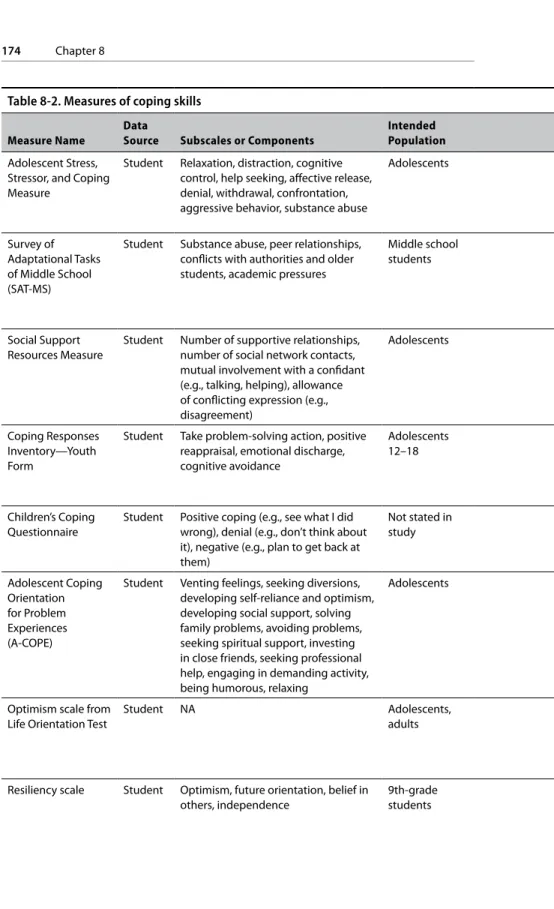
Measurement of resilience—risk Factors, Successful Outcomes, and protective Factors
Family characteristics, such as poverty (Gayles, 2005; Reis et al., 2005) or having a mother with a serious mental disorder (Garber & Little, 1999), also constitute risk factors. The school context, such as high poverty or academically struggling schools, contributes to risks (Shin et al., 2007). The interviews highlight the resilience process and focused on attitudes about oneself in school that can contribute to resilience, such as self-belief (Reis et al., 2005).
One of these studies analyzed items that assessed students' feelings about school subjects and school attendance (Kanevsky et al., 2008).
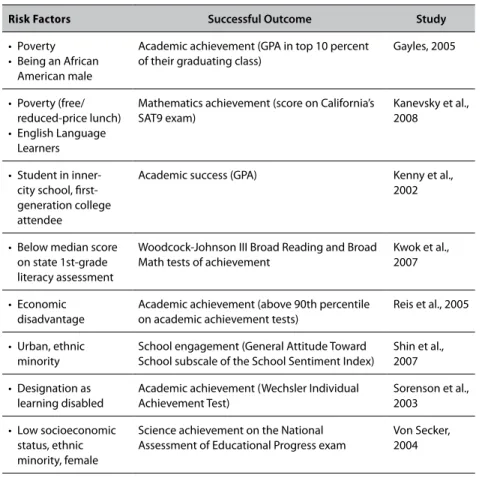
Studies of Coping and resilience and School performance, 1997–2008
Given this focus on at-risk children, researchers selected students participating in programs designed to help at-risk students. Garber and Little (1999) found that at-risk students with positive coping skills, such as trying to learn from their mistakes, remained competent over time. Would we expect resilience to work the same way for all at-risk students regardless of the specific risks they face.
Given that coping and resiliency research focuses on students who respond to stress, many of the studies reviewed here limited analyzes to at-risk children using samples of students who had already participated in programs for at-risk children.
